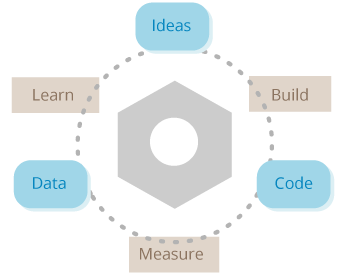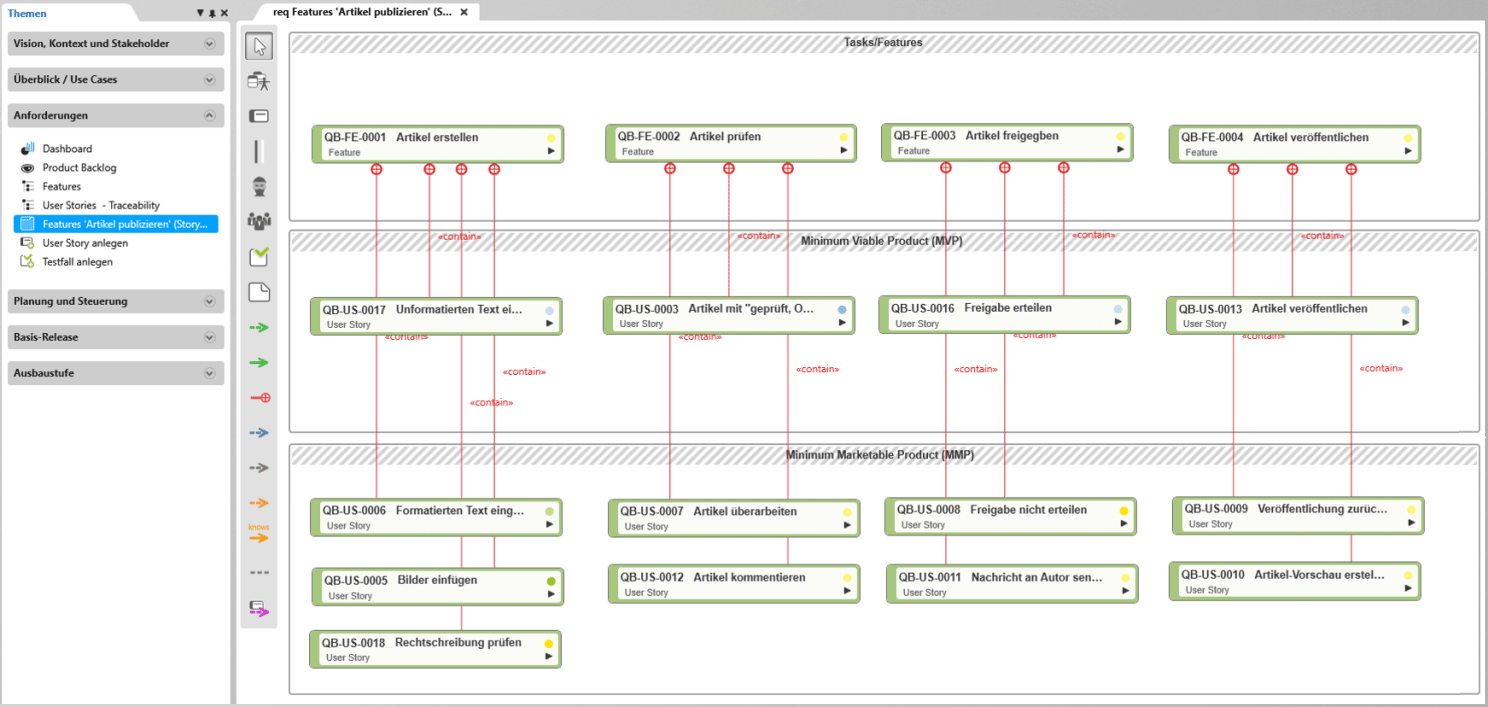MVP. The Minimum Functional Product.
How do you test a new business model with an MVP? How does it minimize costs and risks? What is the difference to the prototype?

The so-called Customer Delight Pyramid is made up of requirements relating to functionality, reliability, usability and convincing design. Functionality naturally forms the foundation, with enthusiasm factors located further up the pyramid.
To create a minimum viable product, the thinnest possible slice with the most promising properties of all layers is selected and realized. This approach is cost-effective and low-risk. It is important that the MVP still represents the business case, as this is the only way to test and validate the business model.
A minimum viable product is then presented to potential users. Their feedback determines the further development of the product.
The MVP goes through n further iterations of the learning cycle: build - measure - learn.
An initial market-ready product, known as a minimum marketable product (MMP), is launched on the market. Demand and feedback from buyers then provide the impetus for further development.
Eric Ries in The Lean Startup
The minimum viable product is that version of a new product which allows a team to collect the maximum amount of validated learning about customers with the least effort.
The Learning Cycle with the Minimum Viable Product
A Minimum Viable Product minimizes the time in the feedback loop: build – measure – learn. Using software as an example, the following process is repeated: Code is developed from ideas using simple and fast means (e.g. open source, sandbox, code refactoring). The result (MVP) provides data (e.g. via usability tests, cohort analysis, search engine marketing, etc.), from which it is learned (e.g. via customer interviews, smoke tests, falsifiability hypotheses, etc.) how the initial ideas must be changed in order to deliver an even better result. This starts the next run through the iterative loop.
Hypotheses on new business models can be validated earlier with the help of MVPs, which shortens the entire learning cycle. This is because MVPs provide data on the basis of which the further development of a product takes place or not. If an MVP does not create value for potential customers, the underlying business idea is dubious. The value proposition has not been fulfilled. This early recognition and appropriate redirection can prevent further undesirable developments. In this respect, the MVP is an important medium for implementing the 3rd and 5th principle of the Lean Startup method.
The 5 Lean Startup Principles
1. Entrepreneurship is everywhere
2. Entrepreneurship needs management
3. Learning by testing (test object is an MVP)
4. Accounting via innovation
5. Build – measure – learn (MVPs minimize lead time)

Steve Blank in video Getting the MVP Right
MVPs are small experiments in front of customers. An MVP is not a cut-down version of a big product, but a shortcut to learning and checking product-market fit.
MVP and Agile Development
An MVP is the result of parallel product and customer development, which one of the founders of the term, Frank Robinson, described as “synchronous development”. MVPs serve to synchronize supply and demand, because both are changing rapidly in times of VUKA. In this respect, the MVP concept fits very well with iterative, agile development. There, too, feedback from stakeholders is obtained again and again via sprint reviews, and results are repeatedly checked in short cycles for their value.
In Scrum, this empirical learning cycle is called inspect and adapt. MVPs do not appear as a term in Scrum, but could correspond to early product increments. According to the Scrum guide, the product owner is responsible for maximizing the value of the development and ensures that the product backlog for developing an MVP includes items that contain the greatest customer value. This means that the product owner is of great importance in the development of an MVP. If the MVP is promising, it is improved iteratively and incrementally in further sprints and repeatedly evaluated by the stakeholders in reviews.
The MVP concept is therefore more of a process than a product and is even applied at the feature level. If a particular feature is very complex or expensive to develop, it can be tested using a Minimum Viable Feature (MVF). The MVF must then, of course, be tried out by potential customers. The feedback received in this way simplifies the decision as to whether the feature should be implemented.
If an initial MVP promises value, it is developed further so that it can be released in a first version. To keep pace with rapid technological change, the focus should be on functions that offer real added value for users. Such an initial marketable product is called a Minimum Marketable Product (MMP) or Minimum Sellable Product (MSP). It reduces time-to-market and validates customer readiness to buy. If an MMP nevertheless turns out to be a flop because it does not find any buyers, feedback is again obtained from the market in order to realign product development accordingly. In any case, a “fast fail” saves time and money.
How to work Agile in Practice
Learn more about agility here with objectiF RPM »
Minimum Viable Product versus Prototype
Getting feedback from users early on is seen as the solution to costly and therefore risky developments that no one wants. Many agile methods agree on this point. Depending on the industry (software development, web development, hardware development, product development), there are a variety of different early feedback generators: MVP, prototype, pretotype, proof of concept, wireframe, pilot, mock-up and many more. The special thing about the MVP is that it is not a trial balloon, but must be usable in real life and thus generate real data. This is also clear from the comparison of MVP and prototype:
MVP
Must be real usable
Is sustainable in that it is further developed
Captures quantitative feedback (numbers, business value)
Is commercial
Prototype
Is not used live
Is a model that can be disposed
Collects qualitative feedback (opinions)
Is not commercial, but tests feasibility, design, etc.
Frank Robinson, SyncDev Process, Tools and Services
Technically, it (MVP) is the product with maximum ROI divided by risk.
Examples for Minimum Viable Products
Zappos
Zappos is an online retailer with over 50,000 apparel items on sale and annual sales of $1 billion. In 2009, Zappos was purchased by Amazon for $850 million. Zappos founder Nick Swinmurn came up with the idea of selling shoes online in 1999. To validate his business idea, he went to a local mall with a camera, photographed shoes there, posted them for sale on a website, and purchased and shipped the shoes once a customer bought online. With this MVP, he tried out whether there was demand for an online shoe store.
Dropbox
Dropbox founder Drew Houston, was convinced that lightning-fast synchronization of documents stored in the cloud would deliver real value. But unfortunately, investors didn’t believe in his value proposition, and a prototype wasn’t quickly or easily feasible because of the technical complexity and online service component. So he shot a three-minute video demonstrating the technology as already existing in real life. His MVP. After a very short time, he had 75,000 requests from early adopters on his beta waiting list and knew there was a market for Dropbox.

